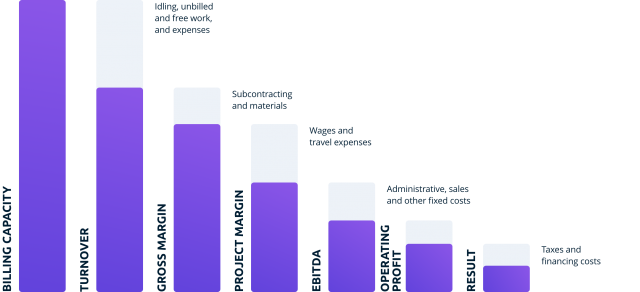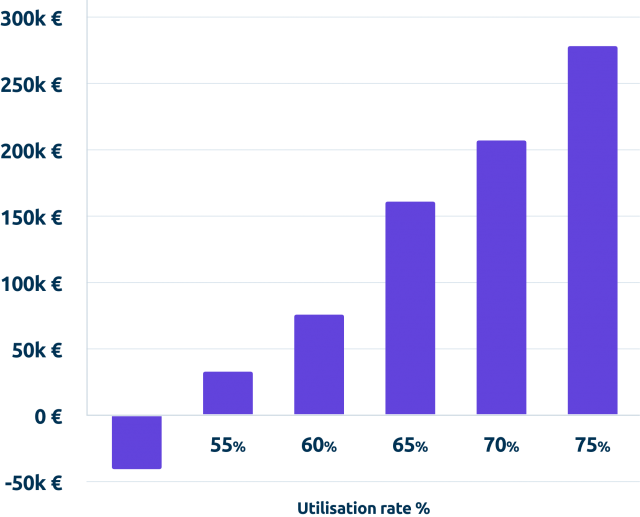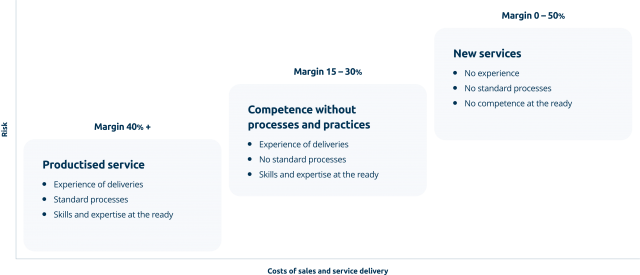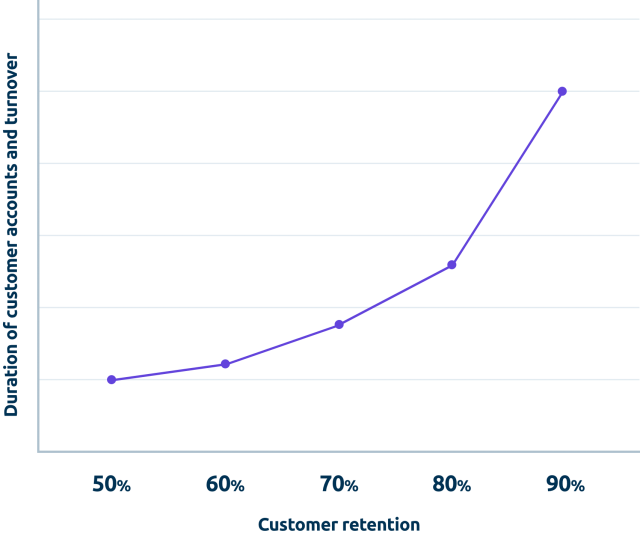A guide to profitable business operations
Welcome to our guide to profitable business! Do you want to learn how to improve the profitability of your professional and project organization? This guide contains collected advice from international experts on improving the profitability of expert companies. By reading the guide, you will learn:
- How leadership has changed and what this means for organizations
- Tips for forming a profitable business model and improving utilization rates
- Maintaining and improving customer retention
Contents
CHAPTER 1
Transformation in the management of professional buiness
A new direction for management and organisations
Matrix, vertical, linear, …what should we be?
Organisations evolve and new winds are blowing. The emphasis in the way in which organisations are structured has shifted from one decade to the next. The results of management research have helped managers develop as leaders and people so that their way of managing business adapts to the time and expectations, while still being profitable.
It is not enough for a company or organisation to define itself as something that conforms to a particular model. Actions speak louder than words. Based on Visma Severa’s extensive customer base and the data and understanding we have gathered, we consider it important to talk about autonomous organisations. At Visma Severa we, as a service partner for a wide range of organisations, see the autonomous organisation as the only sustainable and profitable way to operate now and in the future.
The most important activity for a manager is to enable self-management.
– Frank Martela, researcher (Ph.D.)
Management creates the framework for an autonomous organisation
The rapidly changing world of the 2020s, with its short cycles and pulses, challenges traditional business management and planning. Managing daily business operations and keeping the personnel happy requires a forward-looking approach and proactiveness.
A manager does not need to be constantly aware of micro-level operational activities. Instead, the most important thing is to receive regular input from the operational activities and focus on steering the entire team, unit or organisation.
Proactive and goal-oriented management
Proactive and goal-oriented management differs from traditional management in many ways
- Proactive leadership is not based on micromanagement. Experts themselves are best positioned to influence the organising of their own work within the given framework. This gives them the freedom to take action and responsibility.
- Change is the default setting of a goal-oriented and proactive manager. Plans are made for the for the next couple of months ahead and, whenever necessary, constantly modified on the basis of reporting and forecasts.
- A goal-oriented manager manages short cycles, not a budget. This requires investments in metering and goal setting in advance. An appropriate framework for this is the OKR (Objectives & Key Results) model, for example..
- A goal-oriented and proactive manager manages the overall picture and vision. In this, they are assisted by a digital toolkit and a team they can trust.
An autonomous organisation
A framework for everything to flow within
- The purpose and direction of the business is clear
- Upper-level goals and metrics are of the “SMART” style
- Targets and metrics per team and per individual
- Internal communications communicate changes clearly
The expert knows their work best
- The job description and expectations are clear
- View into the resourcing and reporting of their own working hours
- Possibility to control their own utilisation rate and scheduling
- Accountable for recording the work done in the agreed place within the agreed time
Low hierarchy
- Teams that discuss matters
- Information flows throughout the organisation: no silos
- No micromanaging
- Feedback channels, job satisfaction monitoring and measures
8 tips for a better organisation
The managers of successful companies ensure the following:
- Common and individual objectives (OKRs and KPIs)are clearly defined throughout the organisation.
- No silos: information is shared and communicated between teams and employees.
- An open decision-making culture and good change management engage people.
- Developing the business acumen of experts advancing in their careers, and sharing the raw realities of profit formation.
- Recruiting sales, financial management and IT support specialists for tasks in each of these fields.
- Efficiency of processes in sales, customer service, project execution and billing.
- Establishing clear roles and responsibilities appropriate to the size of the company.
- Performance monitoring and an agile ability to change.
CHAPTER 2
Towards profitable business operations
Result formation

Profitablitiy =Pricing x KUtilisation rate – Expenses

The utilisation rate measures how much of the personnel’s working time is billable.
The company employs:
- 7 experts whose work is billable
- 1 sales rep
- 1 project manager
- 1 CEO
The experts’ billing rate is 80%. This means that the company’s overall utilisation rate is 56%. The calculation employs an hourly rate of EUR 80 for experts and industry averages for cost estimates.
The selection of pricing models matters
Expense-based
- Estimate the costs needed to produce the service
- Add a margin that meets financial targets
+ Easy to implement
– The price often rises slower than the costs
– Some expenses go unnoticed
– The development of competitiveness takes a back seat
– Customer pressure can drive projects into the red
– Coping with market changes?
Value-based
- Write down the benefit received by the customer in concrete terms
- Define the cost level for the delivery of the service
- Select a price where the customer’s benefit and the cost level match in relation to financial goals
+ Usually a better margin
+ Expenses are not taken as a given
+ Less risky than the expense-based model
– A more demanding model to implement
– It is difficult to put a value on the customer benefit
– Customer pressure can drive projects to the red
Market price
- Consider what the customer is willing to pay for the service
- Define the margin necessaryfor achieving the financial targets
- Implement the service at the required cost level
+ Suitable for the customer’s wallet
+ Successful in relation to competitors
+ Costs are planned according to the market
– The most demanding model to implement
– Requires discipline
Do not confuse different pricing models with how you bill the customer. The price can be value-based even if you charge the customer according to hourly rates.
Productisation
Reproducibility drives profitability

7 tips for increasing utilisation rates
- Reward employees on the basis of utilisation rates
- Make sure that the employees see their own utilisation rate on a daily basis
- Make sure that the personnel record billable work on a daily basis
- Delegate the responsibility for billing to project managers or employees
- Leverage technology in the automation of routines, information sharing and reporting
- Optimise sales, ongoing projects and the resources needed for them in a better way with the help of modern tools
- Come up with a business structure that enables a higher utilisation rate
Factors that reduce profitability
The back end is not OK
- Problems in pricing and sales
- Many support roles compared to roles which carry out billable work
- Unnecessary costs and free customer work
- Lack of productisation and processes
Practices and policies are stalled
- Not all hours or costs are logged
- Billable hours, costs and fixed items are missing
- Manual billing causes errors and takes too much time
Responsibility and delegation
- Employee utilisation rate is poor
- Retrieving work-related information takes too much time
- Poor prioritisation and job sharing
- Inadequate tracking of project expenses and hours
The front end is not OK
- Customer or project profitability is not tracked
- Employee efficiency or billing rate is not tracked
- Slow reaction to changes and problems in projects
- No overall picture of the project business
How to improve profitability
Check the list for things you can implement right away.
- Raise prices (specialisation, productisation, added value)
- Improve utilisation rates
- Have junior-level members of the personnel carry out part of the production of services
- Put an end to unprofitable projects and services
- Stop cooperating with unprofitable customers or raise prices
- Bill faster
- Enhance debt collection
- Use marketing to get better projects, not just projects
- Invest in the projects and services with the best margin
- Remove unnecessary overlapping work from the organisation
- Improve your company’s project management skills
- Invest in personnel development
- Eliminate unnecessary fixed costs
- Automate processes and keep administrative and support costs down
- Address underperformers determinedly
CHAPTER 3
Are you heading in the right direction?
Measuring customer satisfaction
The Net Promoter Score (NPS) is one of the most common and simple ways to measure customer loyalty. After a project, call the customer and ask two questions:
- On a scale of 0–10, how likely would you be to recommend us to your friends and colleagues?
- What is the main reason for your answer?
Improving customer satisfaction
After receiving the first NPS results, take immediate action:
- Customers who gave a score of 9–10 are likely to actively market your services to other companies.
- Those who gave a score of 0–6 are primarily dissatisfied and those who gave a score of 0–3 are likely to actively speak negatively about your company.
- This being the case, you should contact those who gave a score of 0–6 again as soon as possible. Don’t try to solve all the problems; instead, focus on the core problem.
Try to end customer accounts that are unprofitable and in which the customer is dissatisfied in an elegant way. Analyse the responses of customers who gave a score of 7–8 and think about how to make them active promoters.
You can calculate your company’s NPS result using the formula shown in the image. The results can be compared to other companies in your line of business.
Customer retention
and its impact on the company’s turnover

How many of your customers actively recommend your business?
95% of business leaders believe they are customer-focused, and 80% believe their products and services are superior. Only 8% of customers agree.*
* Source: Bain & Company: Closing the delivery gap
Project business KPIs
At the level of company and unit
- Billing, gross margin and revenue forecast
- Utilisation rate forecast
- Sales forecast
- Hours to be billed vs. unbilled hours
By project and by customer
- Degree of completion vs. the schedule
- Billing, gross margin and revenue forecast
- Profitability
- Sales forecast
- Customer’s Net Promoter Score
At the level of employee and team
- Utilisation rate
- Proportion of overtime and absences
- Personnel’s NPS (Net Promoter Score)
- Billable hours’ and productive hours’ percentage of working
Practical tips for ERP
- Be more interested in future billing than historical billing.
- Try to forecast the billing and utilisation rate for a period covering several months.
- Ask project managers to update their forecasts on a weekly basis.
- Encourage account managers and project managers to react immediately if the project schedule or cost estimates change. Maybe the customer is still willing to pay for it at this point?
- Create a way to quickly view the entire project portfolio with key indicators.
- Ensure that your organisation also has enough resources for unexpected assignments.
- Make sure that account managers and project managers can easily allocate tasks and monitor their completion.
- Encourage project managers and supervisors to ensure that employees record hours on a daily basis. The number of errors will reduce significantly.
- Monitor time use at the level of the entire organisation together with HR and account managers – especially deviations such as overtime and absences.
- Learn from mistakes and make sure you improve practices and policies.
Lead your professional business with one software.
With Severa, you can seamlessly combine all the functions important for professional businesses, from sales to invoicing, and lead your business predictably towards growth.